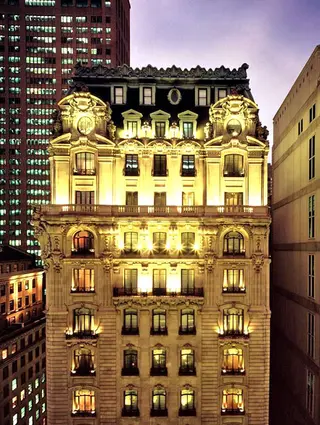 Carter Horsley
Carter HorsleyDec 23, 2011
Carter's Review
In 2005, work began on converted 59 of its rooms into 33 condominium apartments, part of a partial conversion trend at that time that included the Plaza Hotel and the Gramercy Park Hotel. Other hotels at the same time were completed converted included the Empire Hotel at 44 West 63rd Street and the Helmsley Windsor at 100 West 58th Street.
When it opened, this elegant, Parisian-style dowager hotel set new standards for luxury and it is one of Fifth Avenue s fabled gems.
This distinguished hotel was erected by Colonel John Jacob Astor in 1904 and was designed by Trowbridge & Livingston and Sloan & Robertson designed its large expansion along 55th Street in 1927.
Its bronze-domed doorman's sentry box beneath its large sidestreet canopy proudly proclaims its high-tone service. Although its main lobby is relatively small, albeit very lavish, the hotel has always been known for its elegant entertaining rooms. Its "roof," as the hotel refers to its enclosed top floor, still has its pleasant, medium-size ballroom that has lost some of its elegance over the years but still has some wonderful window vistas.
The expansion along the sidestreet enabled the hotel to create an enormous and magnificent club-like bar room highlighted by Maxfield Parrish's large mural of a flatulent "Old King Cole" that originally was in the former Knickerbocker Hotel on the southeast corner of Broadway and 42nd Street that Astor had built shortly after he had erected the larger and more famous Astor Hotel on Broadway between 44th and 45th Streets that was sadly demolished to make way for an office tower. The large bar, unfortunately, was significantly altered in 1991 by the Sheraton hotel chain, to become a dining room and the Parrish mural was moved to a much smaller nearby area that now serves as a bar, which is very attractive just not as grand as the former space.
For many years, the hotel had a famous nightclub, La Maisonette, in which Peter Duchin and his orchestra played in the 1960's, but it has long since been closed.
The St. Regis was the first hotel in the city to be air-conditioned and originally it was reported to have 47 Steinway pianos.
In his excellent book, "Fifth Avenue, The Best Address," (Rizzoli International Publications Inc., 1998), Jerry E. Patterson, provided the following commentary about the St. Regis:
"The public rooms in the St. Regis were relatively small, a subtle indication that the management did not want the crowds that milled in Peacock Alley at the Waldorf=Astoria or in the vast lobby of the Astor in Times Square....On the Fifth Avenue side was an outdoor terrace where one could have refreshments, lost when Fifth Avenue was widened....During the nightclub years of the 1930s the St. Regis had many clubs, attracting for the most part a rather conservative and very well-heeled crowd. Joseph Urban[n], the flamboyant architect, designed the Seaglades nightclub where Vincent Lopez's orchestra played. During the summer they played for dancing in the Japanese-style roof garden of the hotel." The hotel, according to Patterson, was named after the St. Regis Lake in the Adirondacks.
The hotel's Fifth Avenue retail corner unfortunately was reclad in the 1970s in travertine marble that was not sensitive to the great Art Nouveau spirit of the hotel's architecture although it originally housed Buccellati, whose wonderful silver objects were memorably upscale. Buccellati subsequently moved to a different location.
For many years, the St. Regis was the city's most desirable luxury hotel, especially for European visitors and it still retains much of its luster and its ambiance was enhanced by the new and very handsome Takashimaya Building south of it on Fifth Avenue and by the excellent refurbishing of the former Gotham Hotel by the Peninsula chain directly across the avenue. The Peninsula complements the St. Regis wonderfully with a similar but more robust façade.
The announcement that 59 of the hotel's 315 rooms would be converted into 33 apartments came in the wake of the announcement by the new owners of the Plaza Hotel, its major competition for decades, were converting many of its rooms to condominium apartments, an announcement that stirred considerable controversy and eventually led to a reduction in the number of hotel rooms that would be converted.

- Condo built in 1904
- Converted in 2006
- Located in Midtown East
- 46 total apartments 46 total apartments
- 5 recent sales ($165K to $1.2M)
- Doorman
 6sqft delivers the latest on real estate, architecture, and design, straight from New York City.
6sqft delivers the latest on real estate, architecture, and design, straight from New York City.
